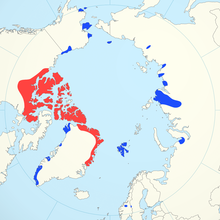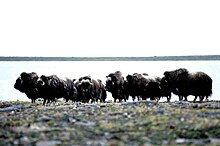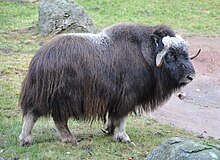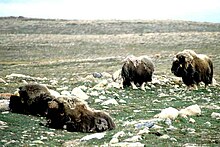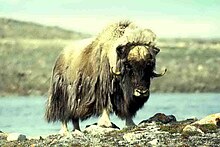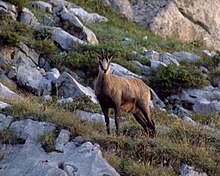Musk ox
| Musk ox | ||||||||||||
|---|---|---|---|---|---|---|---|---|---|---|---|---|

Musk ox ( Ovibos moschatus ) |
||||||||||||
| Systematics | ||||||||||||
|
||||||||||||
| Scientific name of the genus | ||||||||||||
| Ovibos | ||||||||||||
| Blainville , 1816 | ||||||||||||
| Scientific name of the species | ||||||||||||
| Ovibos moschatus | ||||||||||||
| ( Zimmermann , 1780) |
The musk ox ( Ovibos moschatus ), also known as muskrat or sheep ox , is a cloven-hoofed animal from the subfamily of the Antilopinae ; within it he belongs to the family group of goat-like (Caprini). The up to 1.50 m high males and up to 1.30 m high females are inhabitants of the arctic tundras and today originally only found in Greenland , Canada and Alaska . In 1974, however, a herd of musk oxen from Canada and Alaska was successfully resettled in northern Siberia on the Taimyr Peninsula ; the population is estimated at 3,000 to 4,000 animals today. Smaller herds now also live in Norway and Sweden .
paleontology
The precursors of today's musk ox developed about a million years ago in the tundra of northern Central Asia .
The oldest fossils of the musk ox genus Ovibos were found in Germany and date from the Mind Ice Age . These Pleistocene muskoxes differ from their current form in terms of their larger body size and other characteristics and are therefore usually classified as a separate species ( Ovibos pallantis as opposed to Ovibos moschatus ). Their distribution area extended over the northern parts of Eurasia and North America , which they reached about 500,000 years ago via the Bering Strait . In particularly cold periods of time they retreated far south and reached as far as Hungary , France and probably even northern Spain . At the end of the Worm Ice Age , the stocks of the Eurasian deposits in particular declined, probably caused by the disappearance of the mammoth steppes and dry tundras. These dry areas have been replaced by moist moss tundra and dense forests, which the musk oxen have little appeal to as a habitat. In Eurasia they lasted the longest on the Taimyr Peninsula , from where they only disappeared about 4000 years ago. The extinction of the Eurasian musk ox coincides with that of the last mammoths on Wrangel Island in northern Siberia . In the north of North America and northeast Greenland, however , the musk ox survived to the present day.
Paleontological finds show that the musk ox is the last non-extinct species of a multi-species hornbill branch. The muskox owes its survival to its adaptation to extremely cold locations. The extinct species, on the other hand, were adapted to warmer climates (e.g. the Praeovibos priscus , which despite this name was not a forerunner but a species that existed parallel to Ovibos moschatus ).
During the Pleistocene, the helmet muskox ( Symbos cavifrons = Bootherium bombifrons or Bootherium sargenti ) , which was larger and slimmer than Ovibos moschatus , was widespread in North America. Zoological research found it difficult to identify its fossil finds: At first the helmet muskox was thought to be an extinct species of bison ( Bison appalachicolus ), then Bootherium , now generally classified as a female of Symbos cavifrons , was described as a genus of its own. Other fossil musk oxen were Euceratherium collinum , a type of musk adapted to mountain areas, and Soergelia mayfieldi .
origin of the name
The musk ox owes their name to the fact that the males release a substance into the urine during the mating season , which smells musky and sweet; a musk -Drüse such as the musk deer but do not have the musk ox. In Inuktitut , the language of the Eskimos , the musk ox is called Umimmaq (ie "animal with fur like a beard", from umik "beard"). The Latin species name Ovibos means "sheep ox".
distribution
Today musk oxen live in greater numbers in Greenland, Canada, Siberia and Alaska, and as smaller herds in Norway and Sweden. However, only their occurrence in northern Canada and northeast Greenland is of natural origin. In Alaska, the musk ox stocks were wiped out around the turn of the 20th century. Resettlement succeeded after Greenland musk oxen were released on the island of Nunivak off the west coast of Alaska in the 1930s and from there again spread along the arctic mainland.

Resettlements in other regions of Greenland, Siberia and Norway have also been successful. In the Norwegian Dovrefjell National Park, however, it took 20 years of attempts before a musk herd was successfully reintroduced in 1947. Currently (2011) around 300 animals live in Dovrefjell National Park. Animals living in Sweden today come from a herd consisting of one bull, two cows and two calves that moved here from Norway in 1971. Musk oxen were also successfully released on the Russian Wrangel Island in the Arctic Ocean , which was declared a World Heritage Site by UNESCO in 2004 ; they now form a herd of around 100 animals. The settlement on the Taimyr Peninsula was also successful . Attempts to settle in Iceland , however, have so far failed (see also the stock table listed under endangerment ).
Habitat and way of life
Muskoxes prefer low-precipitation tundras as their habitat. They tolerate great cold, but are sensitive to persistent moisture. They are mainly found in lower plains and river valleys, where meltwater and the low rainfall on the permafrost soil collect during the summer and allow vegetation to grow, which is juicy for arctic conditions. They feed on woody plants such as birch and willow , from which they strip the leaves, and on herbs such as sour grasses and sweet grasses , and also on lichens and mosses .
Male animals show a positive food balance (weight gain) for only two months of the year, and their food balance is neutral (no change in weight) for another four months. Females have a positive food balance for five months of the year and a negative food balance for the remaining seven months. Both sexes feed on their fat reserves during the long arctic winter. The females also use their fat reserves when they are suckling their calves.
If an animal is unable to build up sufficient fat reserves for the winter due to poor pasture and weather conditions, there is a risk of starvation, usually in late winter and at the beginning of spring.
A number of other animal species benefit from the presence of the musk ox: snow bunting and spur chambers, for example, pad their nests with the soft musk ox wool that can be found all over the tundra; in winter, ice hare and ptarmigan feed on the plants that have been scratched free from musk oxen. Arctic foxes are not infrequently observed in the vicinity of musk oxen , but so far there is no explanation for this.
anatomy
Shape and size
Musk ox have a stocky shape with thick fat pads that protect against the cold. The hump over the shoulder and the large head in relation to the rest of the body are striking. Adult animals also have a distinctive mane that extends from the withers to the base of the horn. The males weigh 300–400 kg, are 2.50 m long and reach a shoulder height of about 1.50 m. The cows weigh 200–300 kg, are 2.30 m long and up to 1.30 m high.

horns
The horns, which are strongly developed in both sexes , are curved with tips pointing upwards. The horn bases on the forehead of the males are thickened and broadened as elastic bulges, while those of the females are closer together. The horns are used as a weapon against predators and by males during the rut. They begin to grow in the four to six week old calf, but horn formation is only complete around the age of six. It also takes about the same time for the females to reach their final weight, while the males do not stop growing until a year later.
eyes
The eye of the musk ox is well adapted to the special conditions of the arctic habitat: On the one hand, large pupils and highly sensitive retinas ensure sufficient vision when the sun stays below the horizon during the winter months and the moon and stars are the only light source. On the other hand, the pupil can narrow to a horizontal slit or close completely and thus protect against snow blindness . In addition, pigment bodies protect the retina from dazzling sunlight reflected from snow.
Hooves
The hooves are wide, round and sharp-edged. With their larger front hooves, the musk ox are able to scrape away snow or break up ice.
hide
The long, dense fur of the muskox is composed of several different types of hair and extends almost down to the hooves. Above all, the very dense winter fur makes the animals appear massive. Towards the end of winter, this hair is faded and the coat color is predominantly yellow-brown instead of dark to black-brown. On the saddle and on the feet there are also light beige to yellow-brown hair colors; The scrotum and udder are gray-beige. Individual animals and some populations also have light hair on their faces. Older animals are generally a little lighter in color.
A thick, 5 cm long undercoat made of fine wool lies directly on the skin . It covers the whole animal except for the hooves, horns and a small place between the nostrils and lips; his change takes place in the months of May to July. On top of this lies a layer of coarse guard or guard hair, which is considerably longer (45 to 62 cm) and mainly covers the rear, stomach, flanks and throat. The longest protective hair is worn on the throat - hence the name Umimmaq .
The skin has no sebum glands , which is why the hair cannot repel water and rain. The animals, used to a predominantly dry environment, are particularly at risk: Wetness often leads to fatal colds.
At birth, calves have cinnamon-colored outer hair and an undercoat made of dark wool, which, together with the insulating fat deposits, protects them from the cold. The longer top hair first appears at the end of the first year of life.
As mentioned, the musk ox lose their undercoat in the middle of summer. Since their change does not take place at the same time as the awning hairs and the fine woolen hairs stick to the awns, the animals look very shaggy for a while.
The undercoat of the musk ox is one of the finest natural fibers. In relation to its weight, it is eight times warmer than sheep's wool and as soft as the undercoat of cashmere goats . In Alaska attempts have therefore been made to domesticate musk ox as a supplier of wool. The undercoat is combed out of the fur of the semi-tame animals by hand and processed into high-quality scarves and sweaters. A domesticated musk ox supplies an average of 2.5 kg of wool per year, which is used to produce woolen yarn around 18 km in length with a commercial value of around 8,200 US dollars. The wool is under the Inuktitut designation Qiviut commercially.
Reproduction
Female muskoxes become reproductive around four years of age. Male animals reach sexual maturity after six years. Only in habitats with exceptionally good conditions, such as those in Dovrefjell in Norway, do the animals reach sexual maturity earlier.
The mating season is in the summer months of July and August. The cow is 7 to 9 months pregnant and usually gives birth to only one calf, which weighs around 10 to 14 kg at birth. Annual births are possible; however, that depends on the conditions of the habitat.
At birth, the calf has a store of brown adipose tissue that is used to produce heat. The biogeographer Chris Lavers, University of Nottingham (Great Britain), reports that it is possible for a musk ox calf to use this fuel supply in such a way that 13 times as much heat is released as a person at rest.
The suckling period is up to 15 months, although the calves begin to graze as early as a week after birth.
behavior
Behavior in the herd
A herd consists of 5 to 15 animals in summer and up to 100 in winter. The nature essayist and photographer Barry Lopez explains that it is difficult to draw conclusions about the herd composition and typical behavior patterns from individual observations. He emphasizes that the musk oxen is unique among ruminants because they maintain particularly close physical contact with one another and gallop shoulder to shoulder and flank to flank even during the flight. The herds do not only behave synchronously during the escape. The eating and resting phases, each lasting 100 to 150 minutes, are also observed by the entire herd.
Unlike reindeer and especially caribou , musk ox do not go on long hikes, but rather slowly cross their territory every day, covering an average of around 2 km. Both bulls and cows influence herd movement and behavior. So z. B. Observations in Norway that there is always an older cow leading the animals that move as straight as possible.
The summer and winter areas are often only a few kilometers apart. In the Norwegian Dovrefjell, where the living conditions are particularly good for the animals, they stay all year round in an area that is only 8 by 13 km.
Behavior towards predators
The natural enemies of the musk ox are polar wolves , and occasionally ice and brown bears (or grizzly bears ). In the event of an attack, the animals first flee to a slightly elevated or flat place covered with snow and then face the attacker in a phalanx-shaped configuration. Will they z. For example, circled by wolves, this phalanx is circular; the young are protected within this circle. Individual animals - bulls, cows, but also adolescents - then repeatedly break out of the circle and attack the attackers. Wolves are only successful in their attack if they succeed in pushing such an attacking animal away from the herd, or if they can grab a calf through a gap in the phalanx.
Conduct during the rut
During the rutting season there are impressive rank fights among the bulls . The threatening gestures before the actual fight include challenging roaring, rubbing the pre-eye glands on the ground or on the foreleg and pointing the horns and head to the side during a slow, stiff-legged parallel step. During the actual fight, the bulls gallop head-on and crash their foreheads into one another. This can be repeated up to twenty times. The impact is so violent that one of the two fighters often sinks back on the hind legs or both animals point up at each other. It is also part of fighting behavior that the opponents stab each other in the side and thus occasionally injure each other fatally.
Losers generally separate themselves from the herd and subsequently live solitary or join forces with other males. They are only tolerated in the herd if they behave obsequiously to the lead bull.
The recruitment for the females begins in June. The lead bull then follows his females, smells them extensively and begins to plead with his head raised . The advertising becomes more and more intense until August. The cow stops to mate while the bull rides up and clasps its flanks with its forelegs.
Natural causes of death
The females rarely get older than 20 years; the cops, on the other hand, get old at around 15 years of age. The main cause of death is starvation if in the previous year it was not possible to build up sufficient fat reserves to survive the long arctic winter. Death by freezing or drowning is also common when animals break through the ice of frozen rivers in spring. Usually the weakened musk ox are victims of predators. Some also die from injuries sustained during the rutting matches.
Human and musk ox
Endangerment from people
For a hunter equipped with a rifle and accompanied by hunting dogs, musk oxen are easy prey, as the animals remain quietly in a defensive ring when attacked by dogs, as they are by wolves, and thus make an ideal target. For the Eskimos , musk oxen have always been valuable game, which in addition to meat provided them with skin and wool; even horn and bone were used and the short tail as a mosquito whisk.
The hunt for musk ox reached its peak in the late 19th and early 20th centuries. The great polar expeditions used the meat of the musk ox not only for human consumption, but also as food for sled dog teams . Whalers also valued musk ox meat. The Hudson's Bay Company (HBC) was a flourishing trade in the skins; According to its own reports, HBC sold 5,408 musk ox skins between 1888 and 1891.
The purchase of calves by zoological gardens also contributed to the decline of the musk ox population : To catch the calves, the adult animals of a herd were simply shot down, and in this way approx 2000 adult animals were butchered. After the fishing methods became known, the zoos stopped buying musk oxen after 1925.
In Canada, the musk ox has been under protection since 1917 and in parts of Greenland since 1974. As a result, the stocks have clearly recovered (see the following "Inventory table"). In order to maintain tradition, Canada has allowed the Inuit living there to hunt restricted: Since 1970, the Inuit have been allowed to hunt 20 musk oxen a year; Furs and wool can be sold. In Greenland, too, limited hunting is allowed outside the national parks. In Alaska attempts are being made to domesticate musk oxen to such an extent that the wool can be obtained (see section fur above ).
IUCN classification and inventory
| country | approx number |
|---|---|
| Canada | ~ 121,000 |
| Greenland | 9,500-12,500 |
| Siberia (Russia) | ~ 7,800 |
| Alaska (USA) | ~ 3,700 |
| Dovrefjell (Norway) | ~ 300 |
| Härjedalen (Sweden) | 7th |
| total | ~ 145,000 |
The IUCN does not currently list the muskox as threatened. In Germany, after the result of the Federal Nature Conservation Act adopted bundesartenschutzverordnung trade and imports banned by muskoxen to hunt not to favor.
Endangering people
Musk ox are relatively rarely dangerous to humans. In Norway z. B. So far two people have been killed by attacking musk oxen. Since musk oxen who feel threatened do not always flee, but can instead take up their defensive position and attack from it unexpectedly, visitors to Dovrefjell are advised to keep a distance of at least 200 m from the animals, with dogs even at least 500 m.
Subspecies
- Alaskan Muskox ( Ovibos moschatus moschatus ) native to Alaska, Canada and Russia
- Greenland muskox ( Ovibos moschatus wardi ) in Greenland, Svalbard, Norway and Sweden, with a white patch of fur on its forehead
Next related animal species
According to the current state of knowledge, the northern Tibetan takin was the closest related animal species . The serau , the chamois , the mountain goat and the mane jumpers were regarded as further relatives . The close relationship between the takin and the musk ox has been suggested by scientists since 1850, since both animals are similar in physique and behavior. However, genetic studies by scientist Pam Groves do not confirm this. Instead, their research suggests that the closest relative is the Goral , a small species of goat from Asia that is clearly different from the muskox.
References
- ↑ Barry Lopez: Arctic Dreams. 1987, pp. 96, 98 f.
- ↑ a b c as of 1991-2005. - Ovibos moschatus in the endangered Red List species the IUCN .. In: IUCN 2013. The IUCN Red List of Threatened Species. Version 2013.1.
- ↑ Status 2010. - Taras Sipko: "Reintroduction of Musk ox in the Northern Russia." ( Memento from September 5, 2015 in the Internet Archive ) Large Herbivore Network, 2011. Table: Musk-ox-reintroduction-figures.JPG ( Memento from October 18, 2014 in the Internet Archive ), Map: muskox-areal-in-Russia.jpg ( Memento from April 16, 2014 in the Internet Archive )
- ↑ As of 2012. - Norwegian Wikipedia: Moskusfe
- ↑ As of 2011. - Sophie Tunros: “Swedish musk ox population history.” Linköpings universitet 2011.
literature

- Wolf Keienburg (Ed.): Grzimeks Encyclopedia. Vol. 5. Mammals. Munich 1988. ISBN 3-463-42005-8
- Jochen Niehammer, Franz Krapp (eds.); Handbook of Mammals of Europe. Wiesbaden 1986. ISBN 3-89104-026-1
- Chris Lavers: Why elephants have big ears - on the trail of the ingenious blueprint of animals. Gustav Lübbe, Bergisch Gladbach 2001. ISBN 3-7857-2047-5
- Barry Lopez: Arctic Dreams. Düsseldorf 1987 ISBN 3-442-72642-5 (awarded the National Book Award )
- Jork Meyer: Sex ratio in muskox skulls (Ovibos moschatus) found at East Greenland - Sex ratio in the skulls of the muskox (Ovibos moschatus) in East Greenland. ( Memento from February 19, 2009 in the Internet Archive ) (PDF; 302 kB) in: Contributions to hunting and game research. 29.2004, 187-192. ISSN 1436-3895
- Günter Biallawons: My Norway, land of silence, land of light. The musk ox from Dovrefjell. Tecklenborg, Steinfurt 2000. ISBN 3-924044-85-6
- Erhard Treude: On the musk ox keeping in Nouveau-Québec , in: Hans-Josef Niederehe, Alfred Pletsch (ed.): Contributions to the regional-linguistic knowledge of Québec. Geographische Gesellschaft , Trier 1977, pp. 126-139
Web links
- Page Muskox of the VdZ (Association of Zoological Gardens eV)
- Takin as the muskox's closest relative? - English transcript of a radio broadcast from the Arctic Science Journeys
- Ovibos moschatus in the endangered Red List species the IUCN 2006. Posted by: Caprinae Specialist Group, 1996. Retrieved on 12 May, 2006.
